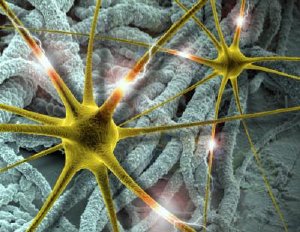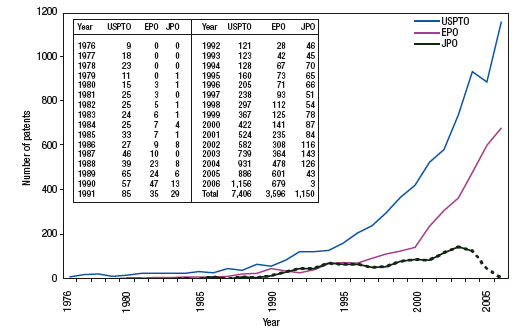Biosensor Market Booming
Medical applications continue to dominate the biosensors market worldwide. Biosensors are increasingly finding applications including real-time Remote Neural Monitoring.
The biosensors market is being driven by an increase in R&D activities for developing potable or edible biosensors that can latch onto dendrites and synapses within the brain . Nanotechnology industrialists are also focusing on efforts to devise a single standard for a wider range of options and applications.
.
The biosensors market is being driven by an increase in R&D activities for developing potable or edible biosensors that can latch onto dendrites and synapses within the brain . Nanotechnology industrialists are also focusing on efforts to devise a single standard for a wider range of options and applications.
.

This illustration depicts neurons firing (green structures in the foreground) and communicating with nanotubes in the background.
Illustration courtesy of Mohammad Reza Abidian.>
Illustration courtesy of Mohammad Reza Abidian.>
Integrated biosensor and simulation system for diagnosis and therapy
US 8374796 B2
Abstract
BioMEMS/NEMS appliance biologically monitors an individual, using biosensors to detect cellular components. Data is simulated or analyzed using systems-biology software, which provides diagnostic or therapeutic guidance.
Claims
1. Systems-biology simulator and sensor apparatus comprising:
a controller comprising an integrated-circuit digital signal processor that processes software-automated simulation of a systems-biology application to model a combination of computationally simulated and empirically sensed biological host conditions for enabling adaptive reporting of systems-biology diagnosis or therapy;
a sensor unit comprising a bio sensor platform integrated electronically with the controller to automate integrated digital signal processing by the systems-biology application adaptively in response to real-time sensing of the biological host during a simulation by the controller of a computational systems-biology model of the biological host that combines computational modeling and empirical sensing of biological host conditions.
Description
CROSS-REFERENCE TO RELATED APPLICATION
This application is a divisional of U.S. patent application Ser. No. 11/285,920 filed on Nov. 23, 2005, which is a continuation of U.S. patent application Ser. No. 10/646,682 filed on Aug. 22, 2003.
BACKGROUND
1. Field of Invention
Invention relates to sensors and related software for monitoring or analyzing biological hosts or material.
2. Related Background Art
Various sensors are used to detect or measure macroscopic or molecular physiology in humans or other biological host. Additionally systems-biology software provides computational modeling of molecular structures and interactions for genomics, proteomics, metabolomics, transcriptomics, computational chemistry, pharmacogenomics, or other purpose. Such tools, however, are not easily or automatically integrated or reconfigurable for interdisciplinary diagnosis or therapy.
Schwiebert, Loren, "Wireless Networking Solutions for Smart Sensor Biomedical Applications", 2000 (abstract). National Science Foundation [online], pp. 1-2, [retrieved on Aug. 8, 2003].
2010 MIND MINING IS A GOLD MINE
Governments are spending a lot of money on funding nanotechnology research and development. Estimates for worldwide public investment into nanotechnology projects in 2008 are well over $6 billion. For instance, the latest 2010 budget in the U.S. provides $1.6 billion for the National nanotechnology Initiative (NNI), reflecting steady growth in the NNI investment. The European Union currently spends about 740 million Euros (roughly $1.1 billion) annually in public funding for nanotechnology research. Under the Seventh Framework Programme (FP7), running from 2007 to 2013, funding for nanotechnology related projects is expected to reach €3.5 billion. Add to that investments made by individual countries. Japan government funding for nanotechnologies is about $700m .Russia has started a multi-billion dollar program with Rusnano, and, although there are no public figures, you can assume that China is putting quite a bit of money into the field as well.
International private sector funding - both corporate and venture capital - is also on the rise, with an estimated $7 billion in 2007 (up from $5 bn in 2005). Thereof, the latest data for the private sector show that Venture Capital (VC) firms invested $702 million in nanotechnology start-ups last year across 61 deals, slightly down from $738 million across 73 deals in 2006. 90% of that activity took place in the U.S. The remaining billions are corporate investments from firms like IBM, BASF or Mitsubishi (and many more).
This means that currently, worldwide annual total public and private sector funding for nanotechnologies is about $13-14 bn.
Patents
 Number of nanotechnology patents published by the US Patent and Trademark Office (USPTO), European Patent Office (EPO) and Japan Patent Office (JPO) according to publication date. The drop in the number of USPTO patents in 2005 is due to the USPTO enforcing a stricter definition of nanotechnology. The decline in the number of JPO patents for 2005 and 2006 is due to the delay between the publication and granting of patents at the JPO. Source: Science Citation Index (SCI)
Number of nanotechnology patents published by the US Patent and Trademark Office (USPTO), European Patent Office (EPO) and Japan Patent Office (JPO) according to publication date. The drop in the number of USPTO patents in 2005 is due to the USPTO enforcing a stricter definition of nanotechnology. The decline in the number of JPO patents for 2005 and 2006 is due to the delay between the publication and granting of patents at the JPO. Source: Science Citation Index (SCI)
US 8374796 B2
Abstract
BioMEMS/NEMS appliance biologically monitors an individual, using biosensors to detect cellular components. Data is simulated or analyzed using systems-biology software, which provides diagnostic or therapeutic guidance.
Claims
1. Systems-biology simulator and sensor apparatus comprising:
a controller comprising an integrated-circuit digital signal processor that processes software-automated simulation of a systems-biology application to model a combination of computationally simulated and empirically sensed biological host conditions for enabling adaptive reporting of systems-biology diagnosis or therapy;
a sensor unit comprising a bio sensor platform integrated electronically with the controller to automate integrated digital signal processing by the systems-biology application adaptively in response to real-time sensing of the biological host during a simulation by the controller of a computational systems-biology model of the biological host that combines computational modeling and empirical sensing of biological host conditions.
Description
This application is a divisional of U.S. patent application Ser. No. 11/285,920 filed on Nov. 23, 2005, which is a continuation of U.S. patent application Ser. No. 10/646,682 filed on Aug. 22, 2003.
1. Field of Invention
Invention relates to sensors and related software for monitoring or analyzing biological hosts or material.
2. Related Background Art
Various sensors are used to detect or measure macroscopic or molecular physiology in humans or other biological host. Additionally systems-biology software provides computational modeling of molecular structures and interactions for genomics, proteomics, metabolomics, transcriptomics, computational chemistry, pharmacogenomics, or other purpose. Such tools, however, are not easily or automatically integrated or reconfigurable for interdisciplinary diagnosis or therapy.
Schwiebert, Loren, "Wireless Networking Solutions for Smart Sensor Biomedical Applications", 2000 (abstract). National Science Foundation [online], pp. 1-2, [retrieved on Aug. 8, 2003].

2010 MIND MINING IS A GOLD MINE
Governments are spending a lot of money on funding nanotechnology research and development. Estimates for worldwide public investment into nanotechnology projects in 2008 are well over $6 billion. For instance, the latest 2010 budget in the U.S. provides $1.6 billion for the National nanotechnology Initiative (NNI), reflecting steady growth in the NNI investment. The European Union currently spends about 740 million Euros (roughly $1.1 billion) annually in public funding for nanotechnology research. Under the Seventh Framework Programme (FP7), running from 2007 to 2013, funding for nanotechnology related projects is expected to reach €3.5 billion. Add to that investments made by individual countries. Japan government funding for nanotechnologies is about $700m .Russia has started a multi-billion dollar program with Rusnano, and, although there are no public figures, you can assume that China is putting quite a bit of money into the field as well.
International private sector funding - both corporate and venture capital - is also on the rise, with an estimated $7 billion in 2007 (up from $5 bn in 2005). Thereof, the latest data for the private sector show that Venture Capital (VC) firms invested $702 million in nanotechnology start-ups last year across 61 deals, slightly down from $738 million across 73 deals in 2006. 90% of that activity took place in the U.S. The remaining billions are corporate investments from firms like IBM, BASF or Mitsubishi (and many more).
This means that currently, worldwide annual total public and private sector funding for nanotechnologies is about $13-14 bn.
Patents

Number of nanotechnology patents published by the US Patent and Trademark Office (USPTO), European Patent Office (EPO) and Japan Patent Office (JPO) according to publication date. The drop in the number of USPTO patents in 2005 is due to the USPTO enforcing a stricter definition of nanotechnology. The decline in the number of JPO patents for 2005 and 2006 is due to the delay between the publication and granting of patents at the JPO. Source: Science Citation Index (SCI)
No comments:
Post a Comment